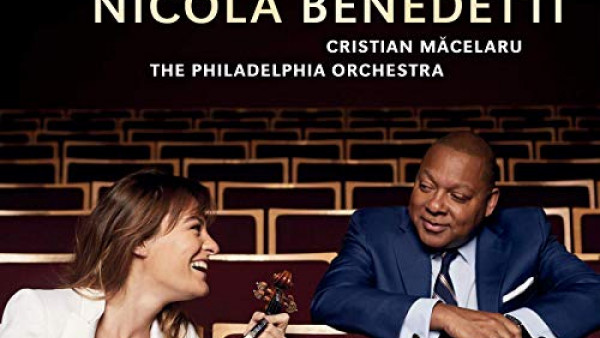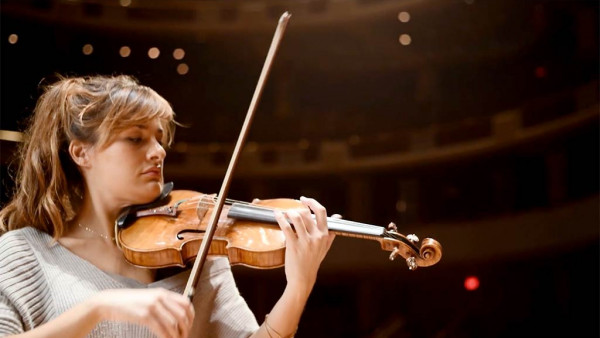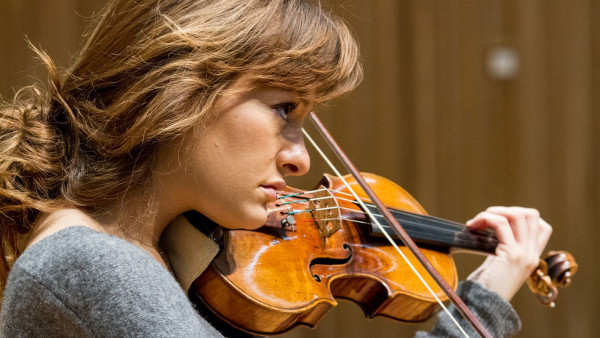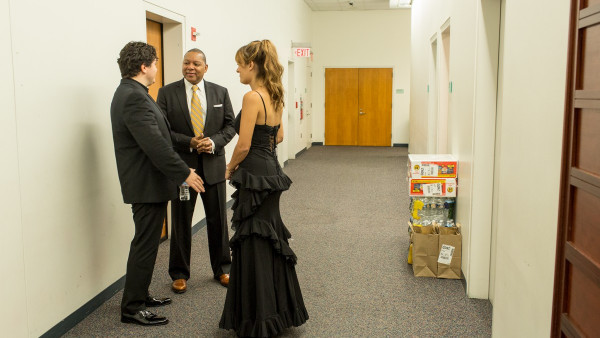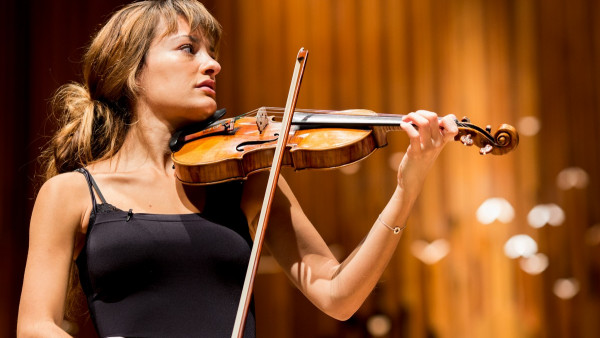About Forms
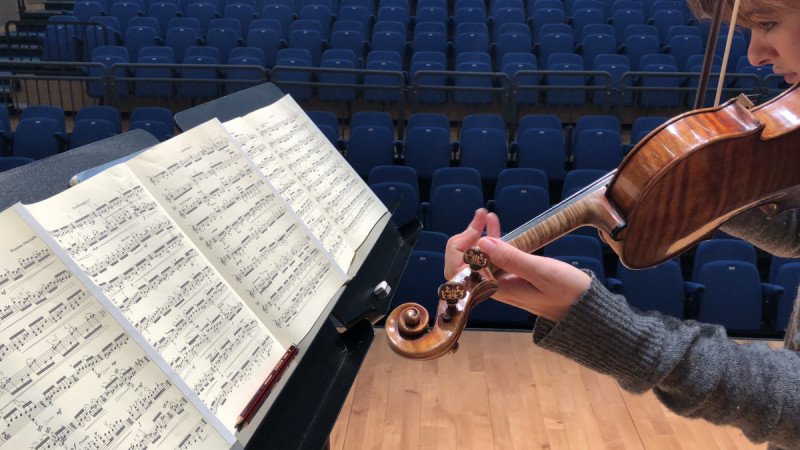
(Nicola Benedetti rehearsing the Violin Concerto)
In 1990, I wrote my first extended composition, Blue Interlude. At that time, Jelly Roll Morton’s and Duke Ellington’s methods of constructing longer, more complex pieces were a great inspiration. In compositions like The Pearls and Creole Rhapsody, they would connect different grooves and harmonic forms with brief organic transitions, while developing and transforming a few distinct motifs throughout. (Of course, playing and studying Papa Haydn’s trumpet from a young age provided an excellent model for developing thematic material through diverse movements).
Over the last few weeks, I have received a number of questions from younger jazz musicians about my method of constructing longer pieces. One night over twenty five years ago, Dave Berger and I set aside a couple of late afternoon hours to analyze Duke’s A Tone Parallel to Harlem. We ended up going on and on until deep into the night, amazed by the intensity of thematic relationships we found (and could have kept on finding). This experience reinforced my understanding of the necessity of a road map for longer works. Themes don’t just mysteriously ‘work themselves out.’ Stanley Crouch once told me, "Monk’s music is hard, because he made it hard."
Composers make deliberate choices. And in this spirit, (and because I want anyone interested in knowing to see exactly how my compositions are built) I am posting the initial and final outlines of the Violin Concerto.
I always begin with a written outline that details intentions and possibilities. If a piece is written for or with someone, I interview them and take notes to get a good baseline of mutual understanding for constructing a form. For me, form is the crucial element and this initial interview is often a highlight of the entire collaborative process.
I can easily recall the fantastically detailed and evocative outline that force-of-nature dancer, choreographer and Artistic Director, Judith Jamison provided for Sweet Release, a ballet we did together in 1996. The great Garth Fagan sent me a beautiful poem detailing the meanings of our 1991 ballet with sculptor Martin Puryear, “Griot/New York”:https://wyntonmarsalis.org/discography/title/griot-new-york. I remember reviewing this poem with my mentor Albert Murray and having my intellect granulated in the process. The master of drums, dance and mythology from Ghana, Yacub Addy, taught me another wholly different way to perceive form when we wrote Congo Square together off and on from 2000 to 2006, and I still reflect on his extremely insightful, direct and pithy sayings. When I told him a rhythm "didn’t sound royal to me" (being from New Orleans where the only kings were of Mardi Gras parades) he replied with a laugh, "That is why you will never play it correctly." He gave me a complete education in much more than music.
Because this Concerto was written for Nicola, in our initial meeting I asked a lot of questions and took notes. From these notes an outline emerges to detail the overall form and direction of the piece. Gradually, over a one or two week period, the outline is filled in with aesthetic intentions, musical techniques and concepts, and the emotional and psychological personality of the piece emerges. Then, appropriate forms are selected and eventually organized in a progression to create the desired effect.
This outline is words only – no musical notation. I review this outline over and over again until it feels right, and then continue to consider and reconsider it. Thanks to my phone, I have the notes from our initial interview in late 2014. Sometimes, I begin by asking human questions like "what would your momma like to hear?’‘ and so on… This is to get us thinking in the larger world and to access a humility that (I feel) makes you more honest, free and creative.
When finally getting to musical notes, the forms that have been worked out on paper will change to follow the direction determined by the music. I don’t impose the predetermined forms on whatever comes to me. Sometimes in crucial moments of a piece, the music wants to do something different from what I want to do. I follow the wishes of the music.
Themes come to me relatively easily, so most of the time composing is spent on development. Orchestration and ‘micro-work’ like marking dynamics, dots and dashes on notes, expressive words and phrasings, size of drum heads, etc… ad infinitum… take up a whole lot of time, demand concentration, and require education and experience. These very tedious, hands-on details truly test your dedication and integrity.
For me, construction of is the most fun. I like to use a multiplicity of forms mixed with the chorus-format style of building (repetition of choruses that have different functions, pioneered by Jelly Roll Morton as far as I can tell); rhythmic cells that define styles from Habanera to Ragtime to 4/4 Swing to some odd metered concoction that has no name. I also use in free combination, all types of musical methods that develop tension and release in jazz: riffs, breaks, call and responses, solos, New Orleans counterpoint, grooves of different intentions and intensities, etc…
I will work on things until I’m satisfied and have no problem changing them over and over again, until it’s done. The form however, almost never changes. With this piece we had the luxury of many performances with great and committed orchestras. After each performance, Nicola would send a list of suggestions about how to make it clearer to play and more impactful for the audience. They ranged from eliminating two measures of the sermon, to many changes in tiny dynamic details. Every comment was practical, intelligent and not at all gratuitous. It was an education in the micro-demands of practical orchestration and in understanding the impact of those decisions on rehearsal time. With large forces, time is not your friend. You don’t even have three minutes to waste on indecipherable instructions. Everything has to be crystal clear. This is much more difficult than you would think, especially if you are trying to create another way to do something with an ensemble that is already very accomplished at what they normally do.
Below is an example of the initial notes from my meeting with Nicola. Following them is the final outline of the piece. Musical forms are indicated, but technical language and details have been omitted - because as Duke always said, such talk "stinks up the place."
Violin Concerto — 30 min
(Initial Meeting: Nov 4, 2014)
Her momma says the contents have to be expressive so she can bring it out.
Her father says concertos are popular because of the melody and the continuity.
Objectives:
A) open and celestial and pastoral and in the bowels--pointillism in the orchestra parts w open intervals, with violin singing a long melody through it. ‘E A’ subliminal drone with pointillistic changes of key while the drone stays like F# Dmaj Bbmaj Fmaj, Gmaj [Romantic and Linear]
B) [make the fast music be the same theme in each movement but get longer until you get to it]
C) from high to higher--- dont stick around . The pointillism keeps time and she is free, she keeps time and they are free — Prokofiev 1st Concerto and Sibelius Violin Concerto opening. End with shimmering.
D) the form should allow her to have growth and not just tinker around. Allow her sound to grow in breadth and dynamics, increase in psychological complexity. The openings of concertos that grab people start w a vulnerable singing violin and grow into an emotional intensity.
E) not too elaborate, keep her leading on the melody and developing into something intense. It should be like one thread that’s growing.
Forms:
1st Movement — slow
Nicky: open, soaring, rapturous, loving, warm, and some nostalgia. A melody that develops, is not busy and leads everything.
Me: go from a Lullabye/Spiritual through midnight to dawn and use long notes. Violin over a bed of sound, maybe pointillism w strings and add one wind the English horn.
RECITATIVE — quarter note. This was developed in the West in the late 1500’s, (pre polyphony like a person humming a spiritual) in the world? Who knows….Go from the sound of blues to the psychological complexity of music after the 60’s.
2nd Movement (quarter=160 Fast)
Nicky: really fiery and dance like. strong like a shock, like a bang. Start smoking with the bow. Not subtle. She should play separate bows like the last mvmnt of Tchaikovsky. String crossing, double stops and spiccato. She wants people to say wow!!!!
Me: Make it virtuosic and showy with explosive climaxes and leave her alone to play a cadenza which leads to the next movement which is a blues.
Use:
Rhythmic-effects. Like SCRIPTURE from Abyssinian Mass.
A lower ground rhythm.
Pizzicato and Bartok pizzes, then she strikes chords and what not and they answer in some configuration.
Intricate and dance like and in changing meters. Have her answer firery phrases and finish off ideas at the top of things. Also Italian low note melody with variations above like Carnival of Venice.
Her examples: Spiccato, Britten - second mvmt of violin concerto, Shostakovitch 1st Vln Concerto 2nd and 4th movement. You can also use the orchestra like percussion to embellish the solo parts. Throaty sound high on the g string (specified).
Me: it should be a rondo. A SECTIONS IN 2/4 4/4 with hits and violin filling space like drum breaks, B, C, D in 3, 5, 7. Start with orchestra playing breaks and she covers the breaks with complex rhythm/melody like proto-modern Ragtime.
Rondo Form:
A) 2/4 Detache’ and spiccato, double stops and repeated chords on down beats
B) 3/4 — scherzo dance rhythm? Theme of third movement of Tchaikovsky (pg 79 mm 53, 81 to 90) Prokofiev 1 pg 36 Beethoven pg 65
A) 2/4 as before — Open string double stops in which on voice is a pedal and the other voice moves ex Szymanowski Concerto
C) 5/4 lyrical section
A) 2/4
D) over ground rhythm in 7/4
A) END WITH POWER
Her breakdown of techniques: Fast String Crossings that include open strings that fit into a detache stroke, playing high on the G string, Doubling and tripling octaves at once (make use of open strings) Shostakovitch last minute.
Examples of extreme string crossings Paganini no 2, Ricochet (Paganini 1st) caprice, octave double of melody (opening of Paganini 3 and 7), (Paganini 9) good use of double stops and string crossings and that rhythm for a heavy rustic effect.
Paganini 15 — broken chords like Bach.
(Paganini 24 well written variations)
Me: end with a flourish and she drips down to the blues.
3rd Movement (quarter = 64 blues)
Really singing in the husky (hushed) register. Sexy. pauses and rubato. Something touching, tender and sweet. stay mainly on the lower two strings. Sibelius 2nd mvmnt.
Blues/ballad melody with riffs.
Make it like she’s talking. Where she can rise and fall. Like Bechet’s Blue Horizon and sound like she’s improvising.
Nicky: it has to be seductive.
Me: like Johnny Hodges w a bow.
FORM: blues with different bar forms.
CADENZA: building in hysteria to a slow blues section.
4th Movement (at 25 min. Quarter=104)
Reel meets Scotland meets Italy.
Something stomping and grooving like a reel. Clapping and stomping, string crossings, chords and double stops.
Nicky: Coda of Korngold Concerto, maybe put a fugue in it (Shostakovitch Scherzo pg 37 to 48). Make people wonder how is she doing this like in some Vivaldi.
Me: use devices of jazz like call and response and shout chorus and trading with soloist a la Blue Devils meets Bob Wills meets Trane. We end big and she walks off playing in a high register (like in a New Orleans parade). Orchestra play some type of three and four together and tap on instruments etc to create a vibe and a groove.
Her note on technical things:
She plays with two bows-- one has a light airy texture, the other has a really romantic deep emotional sound
A) high singing silvery tones
B) string crossing with a baroque bow. You can play bass notes and high moving part at once (like Carnival of Venice)
C) playing legato arpeggios that articulate a harmonic progression
D) concerto grosso section w string quartet.
E) Altissimo A is highest note-- like whistling
F) rough playing in the lower register-- heavy spiccato from
G) write a lot for the lowest and highest strings- you can get more weight behind the E and the G string and not the A and D string
H) think about sonic issues
I) heavy folk rhythms with downbeats in the lower registers
J) each string range is two octaves and a fourth
K) Chords and double stops
L) incorporate silence into the piece so that the movements go from one to another
M) left and right hand pizzicato at the same time
N) cadenza
O) don’t do endless sixteenth note wo bowings. Put slurs in it.
P) vln w percussion alone
Her partial list of epic concertos - I should definitely know: Beethoven, Tchaikovsky, Brahms, Sibelius, Prokofiev, Stravinsky, Glazanov, Shostakovich, Gubaidulina
Violin Concerto — 45 min
(Final Outline: 2015)
Ideas to consider derived from Initial notes.
Meaning is most important. Concentrate on riding the wave of ambiguity that’s in music and in life by not concluding that ambiguity equals no meaning. How to musically negotiate the rapid shifts in our internal states in evoking even the most fundamental experience.
The place of angst in our music is not psychological or conjectural - it is experiential. That’s why grooves represent triumph — when your sitting state is pain, psychosis and insecurity, an evolving and interlocking groove (in odd and even meters together) is the achievement of joy. Maintaining equilibrium is always the challenge. Like the odd and even metered groove, the Blues is sacred and secular at the same time. It is earned optimism but there is no more flexible, nimble and malleable form.
Beware of soundscapes. Know the difference between a soundscape and a progression of ideas. The soundscape is universal because it is generally evocative and showcases technical skills to create the equivalent of wall paper in sound.A progression, however, must find a method of communicating - an a to b to c to a to d and so on.
It goes much deeper than any specific technical skill, this however, cannot compensate for technical ineptitude.
I. RHAPSODY
First Section:
Lullabye - different aspects of tenderness
characteristics: sweet, angsty, nurturing, humble, sexy, sanctified, angelic
TRANSITIONAL SEGMENTS:
A) habenera — liminal state between sleep and dream — concentrate on groove and it being light but firm on the bottom. She accompanies the orchestra like angel dust
B) liminal dream passage to nightmare ---she takes woodwind function, the harp takes her function and the vibes plays a fragment of the habanera rhythm
Second Section:
Nightmare — uncertainty and force
Characteristics: anxious, angsty, introspective, fearful, courageous and definitive, retreating into your mind
This section is the antecedent for the 2nd movement with it’s time changes, emphasis on percussion, use of trombone and police whistle. the vln melody of this section features maj 3rd up and min 3rd down alternations — the harmonic cycle of the second movement moves down a major third and up a minor third. the angsty parts feature a neurotic call and response with vln solo, the returning march is the antecedent for the giacoso. these are sharp crisp changes like a change of mind and disposition. she is a thread through them.
Each of four angsty sections is followed by a more forceful iteration of the march.
The cadenza takes us through states of consciousness and shifts in attitude from internal to external, has a resolution to elegance then a return to angst because it is a nightmare after all.
3rd Section:
Peace — like waters in that crystal stream. john coltrane feel of blues that is not secular to a double turnaround that is flirty and secular. still concentrating on different types of meaning with short transitions.
Characteristics: high minded, wise, deep, serene
This is not a new section but a reiteration of the first
Recap of First Section
Recollection — return to lullabye but as a transcendent combination with the blues
Characteristics: sweet, wistful, optimistic, pristine, pure.
This is not a new section but a reiteration of the first
Fourth Section:
Dance — straight 2 groove dance. drone with rims and stomp board while solo plays rounds through different keys is the combination of the afro american and the anglo celtic tradition that occurred during american slavery but in music it is a memory beyond experience.
Characteristics: gleaming, whimsical, playful, dancing, syncopated, energetic and childlike, like a harlequin or griot.
This is the antecedent for the fourth movement.
II. RONDO BURLESQUE
Sections are self explanatory. very different approach to each section.
a) animato
characteristics: virtuosic and fiery, precise, complex and unapologetic
b) circus
characteristics: acrobatic, mocking, mimicry, ironic, fanciful, make-believe, parody,
c) giacoso
characteristics: raucous, drunken, noisy, playful; rambunctious, unruly
Animato - is terse and secco and the solo playing is very detached, virtuosic and matter-of-a-fact acrobatic. It is 21st century abstract melodic language.
Circus - is playful and long vs short and the solo part is mimicry, parody and elastic. It is the calliope of early riverboat jazz, the jazz-circus connection of Matisse and Stravinsky and it is the happy/sad of a clown face and the fantastic tricks of the various virtuosi and freaks in a carnival circus.
Giacoso - is cacophonous and raucous with sliding strings and percussive effects; the solo part is spiccato and devilish.
The form is ABACADA
B is in 3/4; C is in 5/8; D is in 7/8
A is Animato
B, C, D is Circus
Each Section is concluded with a 3-4 bar tag with an augmented harmonic theme called Giacoso. This is an antecedent for the 3 and 4 bar concluding augmented themes in the solo VLN response to the tutti fiddle tunes in the 4 th movement.
The final A section is followed by a long cacophonous augmented section featuring all of the burlesque elements.
Transition to the African 6/8 is a change in attitude that comes from part o the first movement cadenza. Ride the wave of the 2 versus/and 3 that gives the African clave it’s character.
III. BLUES
The janus expression of opposites. the sections are obvious.
a) flirtation
characteristics: juxtaposition of seriousness and playfulness, quick changes from introspection to sexy to holiness to transcendence, repose, pastoral lyricism
Transition to courtship by way of introspection
b) courtship — mm 43-64.
characteristics: yes but no, no but yes, sexy but halting, threading gold through silver.
concentrate on this triplet rhythm (also african).
sub section of b.
call and response — juxtaposes zen with the sanctified.
characteristics: eastern impassivity with a church response, siren song.
concentrate on the swung triplet rhythm
c) sermon
controlled chaos, multiple call and responses, the trombone signals the beginnings and the brass signal the ends.
characteristics: exhorting, shouting, hollering, repetitive, introspective
d) the big sigh
Important for the intimacy of breath, not strict but flowing like grief itself comes in waves and crests and falls and ends in a whisper then nothing.
characteristic: wistful, absolute loss, cleansing grief, ascendant, transcendence, accepting
IV. HOOTENANNY
a) reel — exuberant, gritty, rough, grooving, dancing, wild, controlled violence
b) spiritual---African, persistent, inevitable, songy, repetitive, optimistic
c) call and response
d) shout chorus ragtime stomp
RECAP OF END OF FIRST MOVEMENT
e) ancestral dance---raucous, stomping, mirthy, dancing, wistful, playful, parading, whimsical
Wynton

